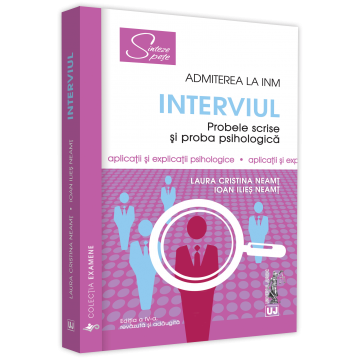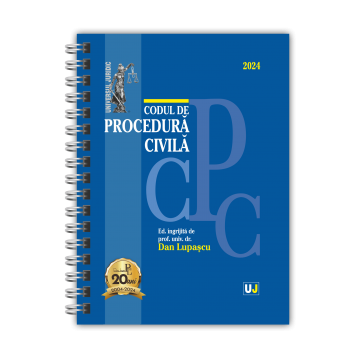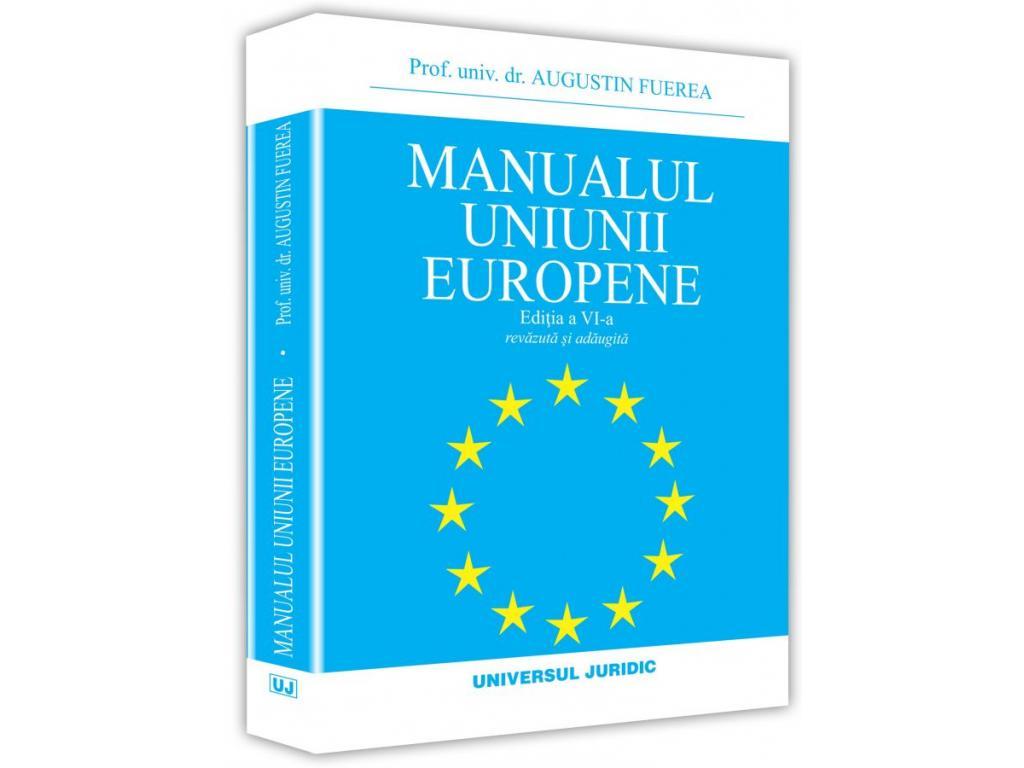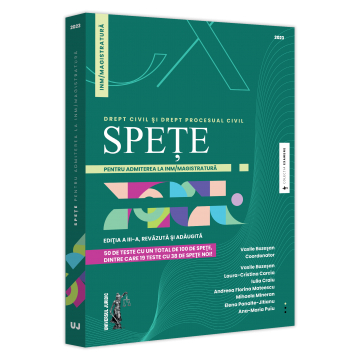ISBN: 978-606-591-601-2
DOI: 10.5682/9786065916012
Publisher year: 2012
Edition: I
Pages: 297
Publisher: Editura Universitara
Author: Kiss Csaba - coordonator, Elizabet Vaia, Lavinia Neacsu, Monica Prostean, Radu Zamfir, Andreea Irina Erceanu, Maria Simina Pop, Elena Delia Boghean
- Description
- Download (1)
- Authors
- Content
- More details
- Where to find it
- Reviews (0)
Armed with such an instrument, the one who would lead the examination could follow if the reactivity of the tested subject, obviously apart from the strict comparisons usually made, falls into one category or another of reactivity.
In order to achieve such a desideratum, an exploratory experimental research on groups of subjects and diagrams was necessary. Given that evaluation and diagnosis in the case of dishonest subjects are much more difficult to achieve, our experimental effort focused primarily on this category, that of lying subjects.
In this context, the present paper is a reunion of research conducted to discover the dynamics of psychophysiological reactivity of the insincere subject. Given the difficult approach and the large number of measurements that had to be performed, the research tasks were strictly limited and distributed over routes, so that each researcher received for investigation a single route of the diagrams, either a respiratory route or a route. electrodermal or cardiovascular. Each of the researchers received a number between 40 and 50 polygraph files, of certain false subjects, which contained at least 3 diagrams with 24 questions, and a number of approximately 5 variables to be quantified for each question, summing for each researcher approximately 6000 measurements. It was a difficult endeavor, which the authors of this paper successfully completed.
The research was carried out in two university centers, in Bucharest, at Hyperion University, within the Master of Judicial Psychology and in Sibiu at Lucian Blaga University, within the Master of Knowledge and Combating Crime. Both master's degrees had as common program, for the first time introduced as a study discipline in Romania, the specialty "Forensic Psychology - evaluation of simulated behavior by polygraph technique". The authors of this book are all masters of the above-mentioned institutions. The works gathered in this volume are careful processing of the best dissertations submitted on the occasion of completing the studies between 2010 and 2012.
The book also contains a chapter on paradigms and modern research conducted from the study of all specialized publications in the last 30 years, with a priority source in the journal "Polygraph" of the American Polygraph Association, a publication of the most significant specialized community in the world. .
.The penultimate chapter of the paper shows us that the polygraph technique can be extremely useful not only in the criminal field, but also in the clinical field to highlight the specific reactivity of trauma updating. The obtained results explain, on the one hand, why the examination of the victims should be avoided and, on the other hand, it discovers an extremely obvious physiological imprint of the trauma and of resistance in time.
In order to complete the image of this discipline, we have also selected an extensive paper that reviews all the means of investigating the simulated behavior from ancient times to the present.
We like to believe that around this valuable tool that is the polygraph, we managed to form a group of researchers attracted and concerned with all that is forensic psychophysiology and, at the same time, we gave answers to practical and theoretical problems of polygraph examination. At the time of its publication, the paper is a unique approach in the field of Romanian and international experimental research.
-
Forensic psychophysiology research. Dynamics reactivity
Download
Elizabet Vaia
Lavinia Neacsu
Monica Prostean
Radu Zamfir
Andreea Irina Erceanu
Maria Simina Pop
Elena Delia Boghean
FOREWORD / 13
Part I - THE POLYGRAPH. History, Ethics and Paradigms / 15
Chapter I - HISTORY / 16
1.1. Brief history of the polygraph / 16
1.2. Brief history in Romania / 26
1.3. Examination method / 27
1.4. Evolution of the method / 30
1.4.1.Evolution of the name / 30
1.4.2.Evolution of paradigms and tests / 31
1.4.3.Evolution of the pretest interview / 32
1.5. Codes of ethics regarding the use of the polygraph in the U.S. and Europe / 34
1.5.1. Codes of ethics in the United States / 34
1.5.2. Codes of ethics in Europe - Great Britain / 37
1.5.3. Codes of ethics in Europe - Romania / 38
1.6. Controversies regarding the use of polygraph tests in criminal investigations / 40
1.7. Poligraful in Romania / 44
1.8. Conclusions45Bibliography / 45
Chapter II - EXAMINATION PARADIGMS USED IN CRIMINAL PSYCHOPHYSIOLOGY / 47
2.1. Control Question Test / 47
2.1.1. Criticisms of the control question / 48
2.1.1.1. Inference rule / 48
2.1.1.2. Handling in administration / 49
2.1.1.3. Non - standard technique and contamination / 49
2.1.1.4. Collateral problems of the investigated / 50
2.1.2. Control question / 50
2.2. Guilt Testing Technique / i52
2.2.1. Guilt Testing / 53
2.2.2. Reasoning for the Guilt Test / 53
2.2.3. Abuse and contamination / 54
2.3.Critical comparison between the Control Question Test and the Guilt Test / 54
2.3.1. Objectivity of the evaluation / 55
2.3.2. Utility / 55
2.4. Conclusion / 55
RESEARCH REGARDING THE VALIDITY AND LOYALTY OF POLYGRAPH TESTERS / 55
2.5. Validity / 55
2.5.1. Laboratory experiments or simulations / 56
2.5.1.1. Validity of the Control Question Test / 57
2.5.1.2. Validity of the Guilt Test and Voltage Peak / 58
2.5.1.3. Validity of the RelevantIrelevant Test / 59
2.5.2. Field experiments / 60
2.5.3. Conclusions / 62
2.6. Fidelity / 62
2.6.1. Fidelity of laboratory studies / 64
2.6.1.1. Fidelity of the Control Question Test / 64
2.6.1.2. Fidelity of the Guilt Test / 65
2.6.1.3. Relevance of the Relevant / Relevant Test
2.7. Conclusions / 65
RESEARCH ON REACTIVITY DIFFERENCES / 66
2.8. Subject categories / 66
2.8.1. Sincere / insincere subjects / 66
2.8.2. Men / women / 67
2.8.3. Non-psychopathic subjects / psychopaths / 67
2.8.4. Subjects with / without family history of alcoholism / 69
2.8.5. Schizophrenic / non-schizophrenic subjects / 69
2.8.6. Extroverted / introverted subjects / 70
2.8.7. Other categories / 70
RESEARCH ON COUNTERMEASURES / 70
2.9.Physical countermeasures / 71
2.10. Mental countermeasures / 72
2.10.1. Imaging / 72
2.10.2. Hypnosis / 73
2.10.3. Biofeedback / 73
2.10.4. Placebo / 74
2.10.5. Desensitization / 74
2.10.6. Personality / 74
2.10.7. Rationalization / 75
2.10.8. Dissociation / 75
2.10.9. Cognitive overload / 76
2.11. Pharmacological / chemical countermeasures / 76
2.12. Behavioral countermeasures / 78
2.13. Conclusions / 78
Bibliography / 79
Part II - RESEARCH ON THE DYNAMICS OF THE PSYCHOPHYSIOLOGICAL REACTIVITY OF THE SUBJECTS EXAMINED WITH THE POLYGRAPH TECHNIQUE / 81
Chapter III - THE RESPIRATORY SYSTEM AND THE RESPIRATORY ROUTE / 82
3.1. Respiratory route - physiology / 82
3.1.1. Respiratory regulation / 83
3.2. Types of main changes in the respiratory tract / 84
3.2.1. Changes in the amplitude of the respiratory rhythm / 85
3.2.2. Changes in the duration of the respiratory rhythm / 86
3.2.3. Temporary changes of the baseline of the respiratory rhythm / 87
3.3. Indicators of psychophysiological reactivity at the level of the thoracic respiratory tract / 87
3.4. Amplitude variables / 88
3.4.1.Average amplitude of thoracic respiration / 88
3.4.2. The average ratio between inspiration and expiration / 88
3.4.3.Modification of the basic level of thoracic respiration / 88
3.4.4. Altitude difference between respiratory cycles / 88
3.5. Longitudinal variables / 89
3.5.1.Length of the chest breathing line / 89
3.6. Temporal variables / 89
3.6.1.Duration of the respiratory rhythm / 89
3.6.2.Duration of thoracic respiratory arrest / 89
3.6.3. Duration of the altitude difference / 89
3.7.Figurative variables / 90
3.7.1.Respiratia eratica / 90
3.7.2.Voluntarily repeated acts / other deeds / 90
3.7.3.Reactive patterns / 90
Bibliography / 91
Chapter IV - THE ROUTE OF THE THORACIC RESPIRATION / 93
4.1. Introduction / 93
4.2. Method / 95
4.2.1. Polygraph Method / 96
4.2.2. Equipment used / 96
4.3. Research results / 97
4.3.1. Dynamics of reactivity of relevant questions / 97
4.3.2. Dynamics of reactivity of control questions / 100
4.3.3. Dynamics of the insincerity coefficient / 101
4.4. Conclusions / 105
Bibliography / 118
Chapter V - THE CARDIOVASCULAR SYSTEM AND THE CARDIOVASCULAR ROUTE / 119
5.1. Characteristics of the cardiovascular system / 120
5.2. Functioning of the circulatory system at the level of the brachial artery in case of a polygraph examination / 122
5.3.Changes encountered in the cardiovascular route - brachial pulse / 122
5.3.1.Changes in the level of the baseline of the graphical representation of the cardiovascular reaction / 122
5.3.2. Changes in the width of the cardiovascular pathway / 123
5.3.3. Changes in heart rate / 123
5.3.4. Premature ventricular contraction (PVC) / 124
5.3.5. Secondary changes / 124
5.4. Indicators of psychophysiological reactivity in cardiovascular pathways / 125
5.4.1. Basic indicators / 125
5.5. Field study on the efficiency of using a cardiac activity monitor / 126
5.5.1. Physiological aspects / 127
5.5.2. Mechanical aspects related to the use of CAM / 127
Bibliography / 128
Chapter VI - DYNAMICS OF THE PSYCHO-PHYSIOLOGICAL REACTIVITY OF THE UNCONSCIOUS SUBJECT EVIDENTED IN THE CARDIOVASCULAR PATH - BRACHIAL PULSE, POLYGRAPH TECHNIQUE / 129
6.1. Introduction / 129
6.2. Method / 133
6.2.1. The purpose of the research / 133
6.2.2. Research objectives / 133
6.2.3. Research sample / 133
6.2.4. Specialized apparatus, instrument and software / 134
6.2.5. Research results / 134
6.3. Research conclusions / 169
Bibliography / 172
Chapter VII - ELECTRODERMAL ROUTE / 173
7.1. Conceptual delimitations / 173
7.1.1. The galvanic response of the skin / 174
7.2. Variables of the electrodermal route / 175
7.2.1. Amplitude of the electrodermal reaction (ARED) / 175
7.2.2.Length of the electrodermal reaction line (LRED) / 175
7.2.3.Duration of the electrodermal reaction (TRED) / 175
7.2.4.Complexity of the electrodermal reaction (MTB) / 176
7.2.5.Medium electrical resistance (EDA) / 176
7.3.Researchers / 176
Bibliography / 179
Chapter VIII - DYNAMICS OF THE PSYCHO-PHYSIOLOGICAL REACTIVITY OF THE UNSINCERITY SUBJECT HIGHLIGHTED IN THE ELECTRODERMAL PATH, POLYGRAPH TECHNIQUE / 181
8.1. Introduction / 181
8.2. Method / 183
8.2.1. Research objectives / 183
8.2.2. Experimental model / 183
8.2.2.1. Operationalization of concepts / 183
8.2.2.2. Sampling / 184
8.2.3. Investigation method / 184
8.2.4. Equipment, tools, specialized software / 185
8.2.5. Statistical analysis of data / 185
8.3. Psychological interpretation of statistical results / 202
8.4. Conclusions and final assessments / 203
Bibliography / 206
Chapter IX - INFLUENCE OF STIMULATION-ACCOMMODATION TESTS IN THE ECONOMICS OF POLYGRAPH EXAMINATION / 214
9.1. Introduction / 214
9.2. Accommodation tests2 / 15
9.3. Method / 218
9.3.1. General hypotheses / 218
9.3.2. The experimental model. Operationalization of concepts / 218
9.3.3. Sampling / 219
9.3.4. Investigation method / 219
9.4. Research results / 220
9.4.1. Statistical analysis of data / 220
9.4.2. Psychological interpretation / 221
9.4.3. Psychological interpretation / 223
9.5. Conclusions / 224
Bibliography / 225
Chapter X - PSYCHOPHYSIOLOGY AND LIE. DIFFERENCES OF PSYCHOPHYSIOLOGICAL REACTIVITY DEPENDING ON THE SERIOUS CRIME AND RECURRENCE EVIDENT BY THE POLYGRAPH / 227 METHOD
Chapter XI - STUDY OF THE PHYSIOLOGICAL DIMENSION FEELING AT THE TRAUMA UPDATE / 237
11.1.Introduction. The theory of psychophysiological reactivity, moods, trauma, theoretical aspects / 237
11.1.1.Theory of reactivity of organisms / 237
11.1.2.Physiological reactions in response to the person's inner world / 238
11.1.3. Mood states / 238
11.1.4.Trauma / 239
11.1.5.The influence of the type of attachment developed in childhood in the context of traumatic events / 240
11.1.6.Physiological reactions felt to trauma awareness / 242
11.2.Method / 243
11.2.1. Research objectives / 243
11.2.2. Research hypotheses / 244
11.2.3.Method used / 244
11.2.4.Equipment used / 244
11.2.5.Measurements performed / 244
11.2.6.Research lot / 244
11.2.7.Research variables / 245
11.3.Research results / 246
11.3.1.Final conclusions / 252
11.3.2.General conclusions / 252
11.3.3.The limits of the polygraph method in trauma assessment / 252
11.3.4.Possible uses of research results / 253
11.3.5. The possible benefits that the study of the physiological dimension can bring to the reconstitution of trauma, in psychotraumatology / 253
11.3.6.Proposals regarding the improvement of the work / 253
Bibliography / 253
Chapter XII - METHODS AND TECHNIQUES FOR DETECTING SIMULATED BEHAVIOR, OTHER THAN POLYGRAPH / 256 TECHNIQUE
12.1.Introduction / 256
12.2.Method of free association / 257
12.2.1.Word List - Stimuli / 258
12.2.2.Latency time / 258
12.2.3.Detection of simulation by free association / 259
12.3.Motor of motor experience / 260
12.3.1.Testing procedure / 261
12.3.2.Research on motor experience / 262
12.4.Techniques for suppressing conscious censorship / 263
12.4.1.Hypnosis - Nature and effects / 263
12.4.1.1. Hypnosis as a method of detecting simulated behavior / 264
12.4.1.2.Examination procedure / 265
12.4.1.3.Hypnosis - countermeasure of the polygraph / 266
12.4.1.4.Admissibility of the method in court / 267
12.4.1.5.Limits of the method / 268
12.4.2.Narco - analysis / 269
12.5.The method of detecting emotional stress in writing / 270
12.5.1. Simulated behavior in writing / 270
12.5.2.Research on the method / 272
12.6. Voice stress analysis method / 273
12.6.1. The theory of micro-tremors / 274
12.6.2.Research on voice stress analysis in simulation detection / 276
12.6.3.Controlled research / 276
12.6.4.Criticisms regarding controlled studies / 277
12.6.5.Research in the field / 278
12.6.6.Fidelity of the method / 279
12.6.7.Voice stress evaluator vs polygraph / 280
12.7.Evoked cortical potentials / 281
12.7.1.Research on the evoked potential P300 / 282
12.7.2.Examination method / 285
12.7.3.Validity of the method / 288
12.7.4.Limits of the method / 288
12.7.5.Evoked potentials vs. Polygraph / 289
12.8.Functional magnetic resonance imaging2 / 90
12.8.1.Mechanism of operation / 290
12.8.2.Validity of the method / 291
12.8.3.Criticisms brought to the method / 292
12.8.4.Limits of the method / 293
12.9.Conclusions / 294
Bibliography / 295
Armed with such an instrument, the one who would lead the examination could follow if the reactivity of the tested subject, obviously apart from the strict comparisons usually made, falls into one category or another of reactivity.
In order to achieve such a desideratum, an exploratory experimental research on groups of subjects and diagrams was necessary. Given that evaluation and diagnosis in the case of dishonest subjects are much more difficult to achieve, our experimental effort focused primarily on this category, that of lying subjects.
In this context, the present paper is a reunion of research conducted to discover the dynamics of psychophysiological reactivity of the insincere subject. Given the difficult approach and the large number of measurements that had to be performed, the research tasks were strictly limited and distributed over routes, so that each researcher received for investigation a single route of the diagrams, either a respiratory route or a route. electrodermal or cardiovascular. Each of the researchers received a number between 40 and 50 polygraph files, of certain false subjects, which contained at least 3 diagrams with 24 questions, and a number of approximately 5 variables to be quantified for each question, summing for each researcher approximately 6000 measurements. It was a difficult endeavor, which the authors of this paper successfully completed.
The research was carried out in two university centers, in Bucharest, at Hyperion University, within the Master of Judicial Psychology and in Sibiu at Lucian Blaga University, within the Master of Knowledge and Combating Crime. Both master's degrees had as common program, for the first time introduced as a study discipline in Romania, the specialty "Forensic Psychology - evaluation of simulated behavior by polygraph technique". The authors of this book are all masters of the above-mentioned institutions. The works gathered in this volume are careful processing of the best dissertations submitted on the occasion of completing the studies between 2010 and 2012.
The book also contains a chapter on paradigms and modern research conducted from the study of all specialized publications in the last 30 years, with a priority source in the journal "Polygraph" of the American Polygraph Association, a publication of the most significant specialized community in the world. .
.The penultimate chapter of the paper shows us that the polygraph technique can be extremely useful not only in the criminal field, but also in the clinical field to highlight the specific reactivity of trauma updating. The obtained results explain, on the one hand, why the examination of the victims should be avoided and, on the other hand, it discovers an extremely obvious physiological imprint of the trauma and of resistance in time.
In order to complete the image of this discipline, we have also selected an extensive paper that reviews all the means of investigating the simulated behavior from ancient times to the present.
We like to believe that around this valuable tool that is the polygraph, we managed to form a group of researchers attracted and concerned with all that is forensic psychophysiology and, at the same time, we gave answers to practical and theoretical problems of polygraph examination. At the time of its publication, the paper is a unique approach in the field of Romanian and international experimental research.
Customer Support Monday - Friday, between 8.00 - 16.00
0745 200 718 0745 200 357 comenzi@editurauniversitara.ro
6359.png)
![Forensic psychophysiology research. Dynamics reactivity [1] Forensic psychophysiology research. Dynamics reactivity [1]](https://gomagcdn.ro/domains/editurauniversitara.ro/files/product/large/cercetari-de-psihofiziologie-criminalistica-dinamica-reactivitatii-1182-988855.jpg)














